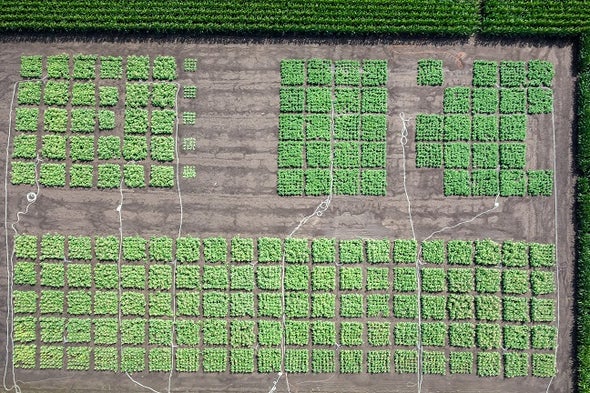(单词翻译:单击)
听力文本
This is Scientific American's 60-second Science, I'm Christine Herman.
Tobacco plants of, course, are grown to make cigarettes. But tobacco is also used a lot in scientific research. And a new study shows tobacco can be genetically engineered to churn out large amounts of a commercially important bacterial enzyme known as cellulase. The enzyme has many industrial uses, including as an agent in the production of biofuel.
And even while their plant machinery is being co-opted as an enzyme-making factory, the plants suffer no reduction in yield while grown out in the field compared with unaltered plants. That fact is rather remarkable, because you might suspect that when a plant is expending resources to create large amounts of cellulase it would struggle to grow. But that's not the case here.
The proof-of-concept study is in the journal Nature Plants.
University of Illinois plant biologist Justin McGrath is a co-lead author of the study. He says the work could lead to lower costs for producing useful proteins like enzymes and some vaccines. That's because it can be way cheaper to cultivate tobacco plants in a field than to grow genetically modified yeast and other microbes indoors in large fermenters. Here's McGrath:
"Our estimates from this study are that it would cost between 20 cents and one dollar to produce a gram of this cellulase, whereas current methods, depending on the type of method you're using, could cost from a couple hundred dollars to a couple thousand dollars."

Growing such plants in the field rather than indoors also makes it much easier to pursue really large-scale production of medicinal and industrial proteins.
But any time you talk about growing genetically modified plants out in open areas, there's a concern that the DNA inserted into the crop could escape and find its way into other organisms. But the researchers safeguard the system against such an incident by avoiding the cell nucleus, where DNA is available to be duplicated and passed along. Instead, they modified the DNA in the chloroplasts—organelles responsible for photosynthesis, not reproduction.
"That adds a very nice safety feature." Rainer Fischer, a veteran biotechnology researcher at Purdue University. He wasn't involved in this study. "So basically you don't have any chloroplasts in tobacco pollen, so there should be no danger for outcrossing" — that is, no foreseeable risk of having the foreign DNA find its way into other plants in nature.
Further research will determine if this system can work to produce other valuable enzymes, which could help transform the tobacco plant from health enemy to ally.
Thanks for listening for Scientific American — 60-Second Science. I'm Christine Herman.
参考译文
这里是科学美国人——60秒科学系列,我是克里斯汀·赫尔曼。
人们种植烟草植物自然是用来制作香烟的。但烟草也大量应用于科学研究。一项新研究表明,烟草能被基因改造,以大量生产一种在商业上非常重要的细菌酶——纤维素酶。这种酶有多种工业用途,包括作为生物燃料生产的制剂。
经改造后,即使烟草的植物机制被选为制造酶的工厂,与未经改造的烟草相比,其在野外生长时产量也不会降低。这一事实相当引人注目,因为你可能会怀疑,当植物消耗大量资源来创造大量纤维素酶时,它会难以生长。但这里的情况并非如此。
这项概念验证研究发表在《自然·植物》期刊上。
伊利诺伊大学的植物生物学家贾斯汀·麦克格拉斯是这项研究的其中一个主要作者。他表示,这项研究可以降低酶和某些疫苗等有用蛋白质的生产成本。这是因为在野外种植烟草,比在室内大型发酵桶中培养转基因酵母和其他微生物要便宜得多。下面是麦克斯拉斯所说:
“我们通过这项研究估计,生产1克这种纤维素酶的成本在20美分到1美元之间,而目前的方法,依据你所使用的方法类型,可能会花费数百至数千美元。”
在野外而不是室内种植这些烟草,还可以使人们更容易获得大规模生产的药用和工业蛋白质。
但每次你在开放区域种植转基因作物,人们就会担心,植入作物中的DNA会逃跑,进到其他生物体中。但研究人员通过避开细胞核来保护该系统免遭此类事件,细胞核是DNA进行复制和传递的场所。相反,他们修改了叶绿体中的DNA,叶绿体是负责光合作用而不是繁殖的细胞器。
“这增加了一个非常好的安全特征。”普渡大学的资深生物技术研究员莱纳·费舍尔说到。他并未参与这项研究。“因此,烟草花粉中基本上没有任何叶绿体,所以应该也不会有异型杂交的风险”——也就是说,就外来DNA进入自然界中其他植物来说,目前没有可预见的风险。
进一步研究将确定该系统能否产生其他有价值的酶,这可能有助于将烟草从健康敌人转变为盟友。
谢谢大家收听科学美国人——60秒科学。我是克里斯汀·赫尔曼。
译文为可可英语翻译,未经授权请勿转载!
重点讲解
重点讲解:
1. churn out 快速生产;大量生产;
He began to churn out literary compositions in English.
他开始用英文创作大量的文学作品。
2. lead to 招致;致使;导致;
Technological changes will inevitably lead to unemployment.
技术变革必然会导致失业。
3. depend on 取决(于);有赖(于);
The cooking time needed depends on the size of the potato.
所需的烹饪时间取决于土豆的大小。
4. rather than 而非;胜于;而不是;
The problem was psychological rather than physiological.
问题是心理方面的而不是生理方面的。


